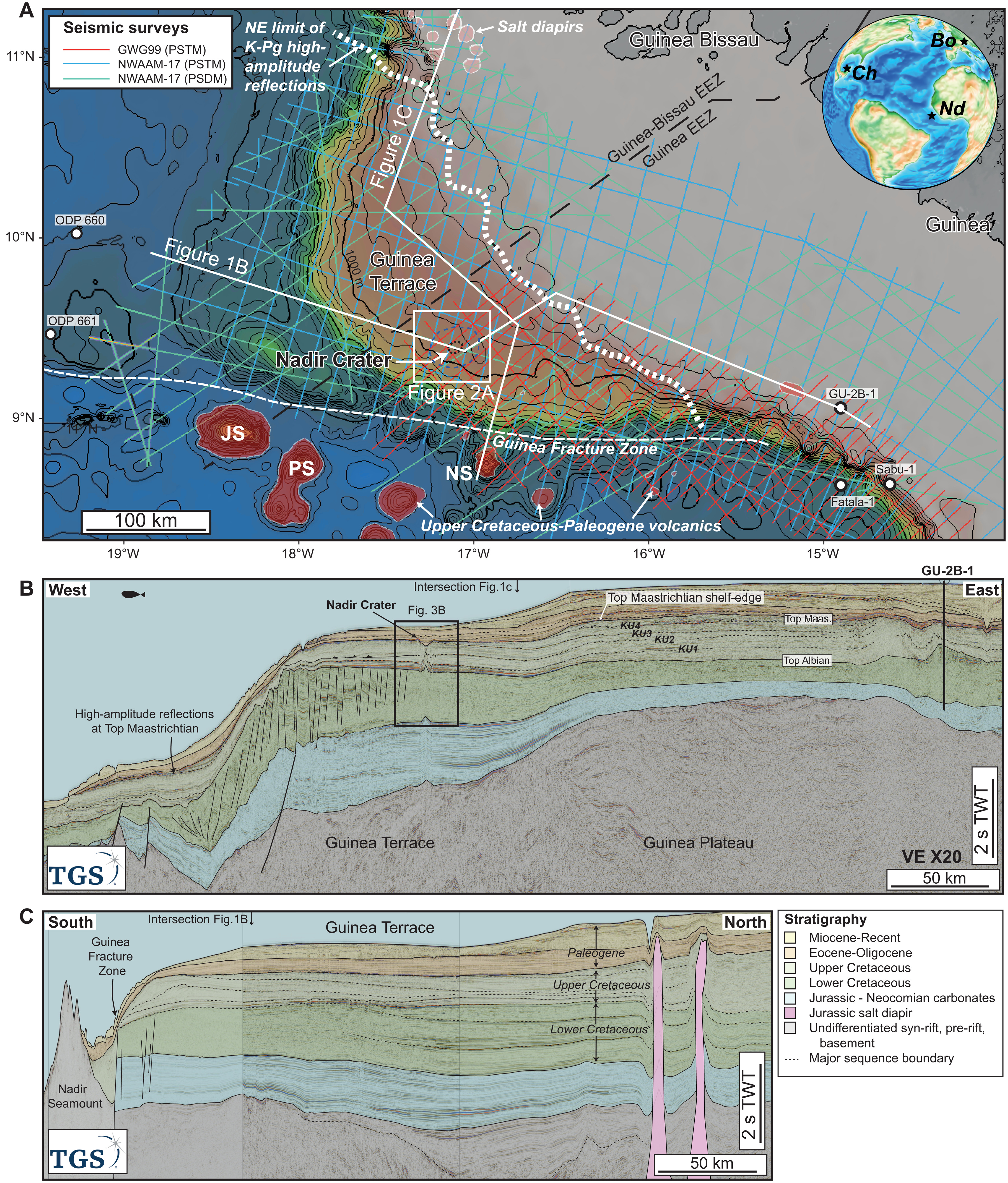Nadir Crater on:
[Wikipedia]
[Google]
[Amazon]
 The Nadir crater is an undersea feature on the Guinea Plateau in the
The Nadir crater is an undersea feature on the Guinea Plateau in the
 The Nadir crater is an undersea feature on the Guinea Plateau in the
The Nadir crater is an undersea feature on the Guinea Plateau in the Atlantic Ocean
The Atlantic Ocean is the second-largest of the world's five oceans, with an area of about . It covers approximately 20% of Earth's surface and about 29% of its water surface area. It is known to separate the " Old World" of Africa, Europe ...
, off the coast of Guinea
Guinea ( ),, fuf, 𞤘𞤭𞤲𞤫, italic=no, Gine, wo, Gine, nqo, ߖߌ߬ߣߍ߫, bm, Gine officially the Republic of Guinea (french: République de Guinée), is a coastal country in West Africa. It borders the Atlantic Ocean to the we ...
. It is suggested to be an impact crater
An impact crater is a circular depression in the surface of a solid astronomical object formed by the hypervelocity impact of a smaller object. In contrast to volcanic craters, which result from explosion or internal collapse, impact craters ...
. The feature is named after the Nadir Seamount, located 100 km to the south, and is around 8.5-km-wide. The paper announcing the discovery of the feature was published in ''Science Advances
''Science Advances'' is a peer-reviewed multidisciplinary open-access scientific journal established in early 2015 and published by the American Association for the Advancement of Science. The journal's scope includes all areas of science, incl ...
'' in 2022. It has been proposed that the structure be drilled to confirm/disprove the impact origin.
Impact event
The crater features all characteristics of an impact event: appropriate ratio of width to depth, the height of the rims, and the height of the central uplift. It was formed at or near theCretaceous–Paleogene boundary
The Cretaceous–Paleogene (K–Pg) boundary, formerly known as the Cretaceous–Tertiary (K–T) boundary, is a geological signature, usually a thin band of rock containing much more iridium than other bands. The K–Pg boundary marks the end of ...
about 66 million years ago, around the same age as the Chicxulub crater
The Chicxulub crater () is an impact crater buried underneath the Yucatán Peninsula in Mexico. Its center is offshore near the community of Chicxulub, after which it is named. It was formed slightly over 66 million years ago when a large ast ...
. Numerical simulation
Computer simulation is the process of mathematical modelling, performed on a computer, which is designed to predict the behaviour of, or the outcome of, a real-world or physical system. The reliability of some mathematical models can be deter ...
s of crater formation suggested a sea impact at the depth of around 800 m of a ≥400-m asteroid
An asteroid is a minor planet of the inner Solar System. Sizes and shapes of asteroids vary significantly, ranging from 1-meter rocks to a dwarf planet almost 1000 km in diameter; they are rocky, metallic or icy bodies with no atmosphere.
...
. It would have produced a fireball with a radius of >5 km, instant vaporization of water and sediment near the seabed, tsunami
A tsunami ( ; from ja, 津波, lit=harbour wave, ) is a series of waves in a water body caused by the displacement of a large volume of water, generally in an ocean or a large lake. Earthquakes, volcanic eruptions and other underwater explo ...
waves up to 1 kilometer high around the crater and substantial amounts of greenhouse gases
A greenhouse gas (GHG or GhG) is a gas that absorbs and emits radiant energy within the thermal infrared range, causing the greenhouse effect. The primary greenhouse gases in Earth's atmosphere are water vapor (), carbon dioxide (), methane ...
released from shallow buried black shale
Shale is a fine-grained, clastic sedimentary rock formed from mud that is a mix of flakes of clay minerals (hydrous aluminium phyllosilicates, e.g. kaolin, Al2 Si2 O5( OH)4) and tiny fragments (silt-sized particles) of other minerals, especiall ...
deposits. A magnitude 6.5–7 earthquake would have also been produced. The estimated energy yield would have been around 2×1019 Joules (around 5000 megatons
TNT equivalent is a convention for expressing energy, typically used to describe the energy released in an explosion. The is a unit of energy defined by that convention to be , which is the approximate energy released in the detonation of a m ...
).
To constrain the age of the crater, which now has an uncertainty in the structure's age of about one million years, and to confirm the impact nature of the event, drilling sediment cores from the crater and testing of minerals from the crater floor is key and has been proposed.
Impactor
The impactor is estimated to be around 400 m in diameter, roughly equivalent to the size of the Bennu asteroid. The authors of the paper speculated that it may have been part of abinary asteroid
A binary asteroid is a system of two asteroids orbiting their common barycenter. The binary nature of 243 Ida was discovered when the Galileo spacecraft flew by the asteroid in 1993. Since then numerous binary asteroids and several triple ast ...
with the Chicxulub impactor or part of an impact cluster, but it is also probable that is unrelated. Impacts similar in size to Nadir occur on average every 50,000 to 100,000 years.
References
{{Coord, 9.395, -17.080, display=title Geology of the Atlantic Ocean Cretaceous–Paleogene boundary Possible impact craters on Earth